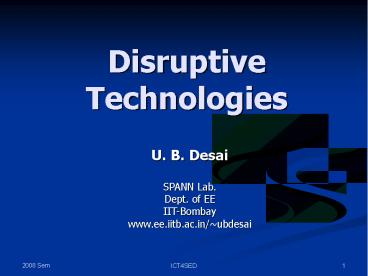Disruptive Technologies - PowerPoint PPT Presentation
Title:
Disruptive Technologies
Description:
Disruptive Technologies U. B. Desai SPANN Lab. Dept. of EE IIT-Bombay www.ee.iitb.ac.in/~ubdesai What is disruptive technology? Working Definition: Technology which ... – PowerPoint PPT presentation
Number of Views:264
Avg rating:3.0/5.0
Title: Disruptive Technologies
1
Disruptive Technologies
- U. B. Desai
- SPANN Lab.
- Dept. of EE
- IIT-Bombay
- www.ee.iitb.ac.in/ubdesai
2
- What is disruptive technology?
- Working Definition
- Technology which creates a major (positive)
disruption in the way society functions - Best explicated thru examples
3
Examples of Disruptive Tech.
- Sun Microsystems Workstations disrupted the
market for main frame computers. - PCs disrupted the market for workstations
- Xerox plain paper copier disrupted the market
for offset printing. - Cannons desktop photocopiers disrupted Xeroxs
high speed photo copying market.
4
- Honda motorcycle of 60s
- Japanese cars of 70s
- Korean Cars of late 80s
- Wireless telephony (GSM, CDMA) disrupted the
market for wire-line telephony. - Nirma
5
- Impacting technologies are disruptive
- Disruptive innovations are products and services
that initially aren't as good as those that
historically have been used by customers in
mainstream markets, and therefore can take root
only in new or less-demanding applications,
amongst non-traditional customers - Stuart Hart and Clayton Christensen
6
Historically
Major waves of growth thru forays at the
bottom of the developed markets (DM)
DM
7
The World Pyramid
Population in millions
Purchasing Power Parity (PPP)
200 mil
gt20,000
Tier 1
800 mil
Tier 2 3
2000 to 20,000
less than 2000
5000 mil
Tier 4
8
The Pyramid
- Examples of Xerox, Cannon copiers, PCs, Cell
phones, etc. represent technologies developed for
the second Tier (to some extent Tier 3) - To date most disruptive technologies have been
attacking Tier 2
9
Advocated by C. K. Prahalad
Attack the bottom of the pyramid. Likely to
create greater disruption
bottom of the pyramid
10
Pyramid for India
Population in million
Purchasing Power
gt 5 lakhs
10 mil
T1
50 mil
3 to 5 lakhs
T2
1 to 3 lakhs
150 mil
T3
50K to 1 lakh
200 mil
T4
550 mil
less than 50K
T6
11
Opportunities at the Bottom of the Pyramid
- Nearly ½ billion in India (4 to 5 billion world
wide) at the bottom of the pyramid - Need to develop new technologies for Tier T4 and
T5 - New business models are needed
12
Examples of Attacking the Bottom of the Pyramid
- New Business Models
- PCO-STD-ISD booths (Pitroda)
- Hindustan Lever (Chache Story)
- Amul Dairy
- Grameen Bank, SEWA Bank (Micro-financing)
- Grameen Telecom (Bangladesh)
- Microfinance (Vikram Akula)
- Technologies
- N-Logue (Village Internet Kiosk using CorDect
Wireless Tech.) - TVS (Kirana Shop Computers)
13
N-Logue corDECT Village Kiosk
- Consists of
- Wireless corDECT wall-set for Internet and
telephone, PC, dot matrix printer, battery back
up, web-cam, speakers, microphone --- for Rs.50K - Local entrepreneur operates the kiosk
- These kiosks becoming community centers
- Expect cities to outsource their work to villages
(Indian villages could become back office to
Indian urban centers a hyperbole) - RTBI Rural Technology Business Incubator
14
TVS Kirana Computers
- For Kirana stores with sales of Rs.100,000 per
month - A rugged PC
- No out right purchase of software or hardware
Pay Rs.2,500.00 per month. - Software for accounting, inventory, etc.
- In 180 days there was a 3.9 increase in profit
15
Change of Mindset ...(from C. K. Prahalad)
- Poor as an opportunity
- Global Market of 4.5 billion?
- Poor as Active Market
- Innovation and development of new technologies
with usefulness to the Poor - Imagination Constraint
- Poor as a Problem
- Poor as Wards of State
- Old Technologies
- Old Technologies Follow the West
- Resource Constraints
Information Access will be a great asset
16
Change of Mindset (from CK Prahalad)
The Poor ofIndia is an Intractable Problem
The Poor ofIndia is a Potential Market
The Poor ofIndia can be A Source of Innovation
Poverty Alleviation, Subsidies
Creating a New Market, Innovation, Growth
17
Challenges
- The Market is Very Fragile
- (Monsoons, Subsidies,.)
- Middlemen and Moneylenders
- Fragmented Experiments
- Lack of a Global database
- Traditional Ways of Thinking
18
References
- C. K. Prahalad and Allen Hammond, Serving the
Worlds Poor, Profitably, Harvard Business
Review, September 2002 - C K Prahlad, spoke about at the annual session of
the Confederation of Indian Industry, held
recently in Bombay. Prahlad said the Indian
economy has the potential to grow 10 to 15.
http//www.moneycontrol.com/promos/prahlad.html - The Great Leap Downward http//idbdocs.iadb.org/w
sdocs/getdocument.aspx?docnum996849
19
Home Work Questions
- Why is there so little technological innovation
and development, where the need is maximum? - Why has Fortune at the bottom of the Pyramid not
taken off? - Is there something wrong with the theory?
- Think of three disruptive technologies that can
change the lives of poor in India
20
(No Transcript)































